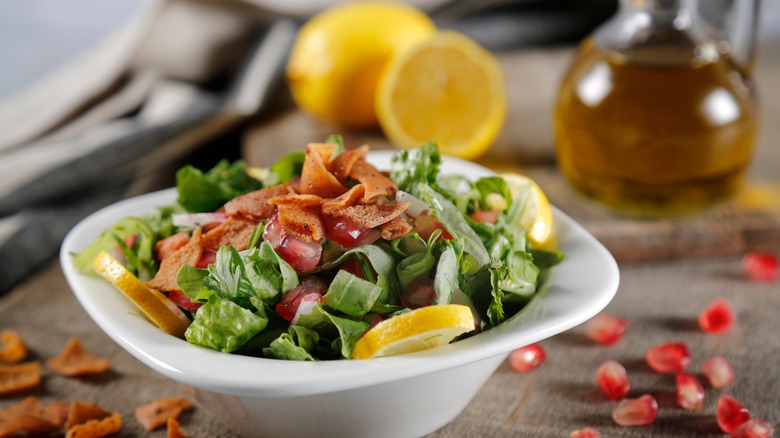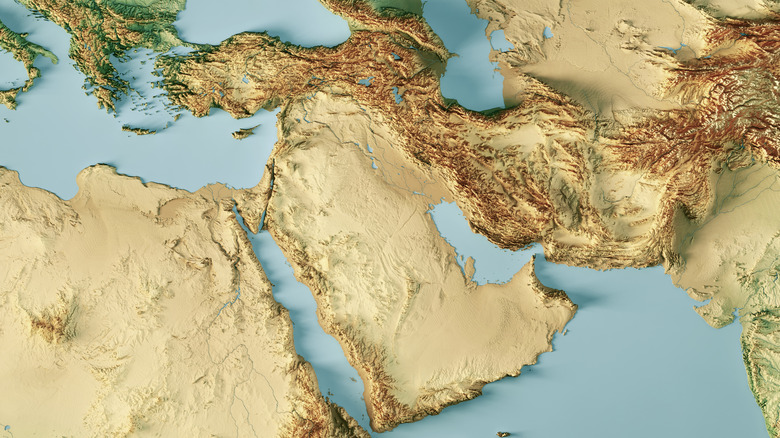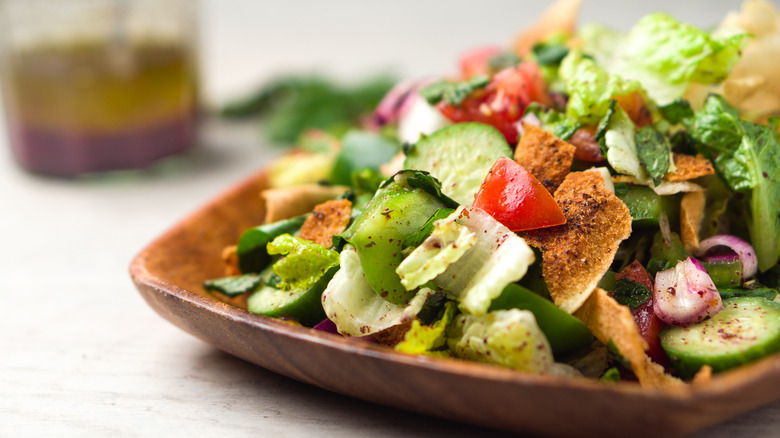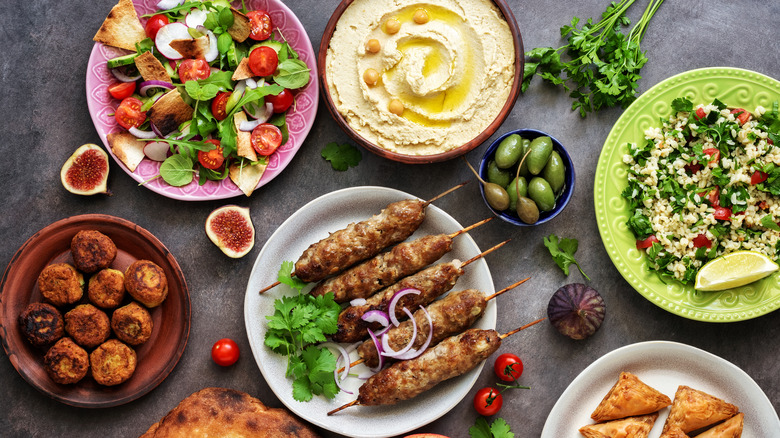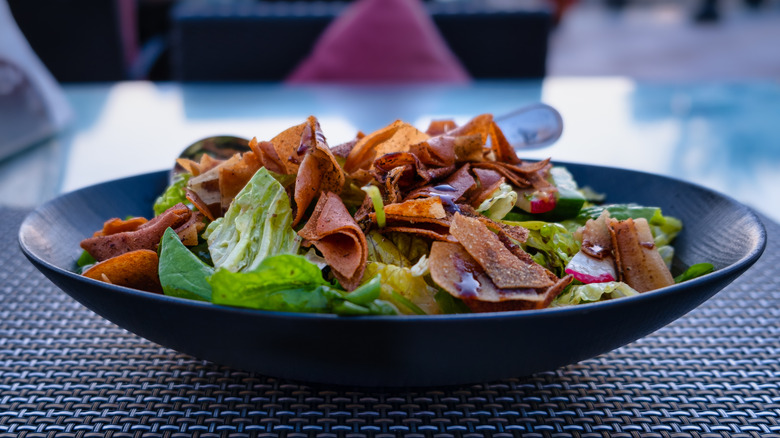The Leftover Origins Of Fattoush Salad
Middle-Eastern cuisine — much like its close cousin, Mediterranean food — is famous for its bold flavors, fresh ingredients, and traditional recipes that have been passed down from generation to generation. A few favorite Mediterranean and Middle-Eastern dishes include hummus, falafel, tabouleh, baba ganoush, Greek salad, and fattoush. Specifically, fattoush is said to have some humble and surprisingly recent origins.
You might know fattoush as a salad that is loaded with fried pita chips, tomatoes, lettuce, cucumbers, and radishes. It's crunchy, textured, nutritious, and is also packed with delicious flavors. On some occasions, people refer to this dish as a bread salad, given that the pita is the star ingredient.
What started out as little more than a common Lebanese mix of leftovers has since spread to become a staple that no respectable Middle-Eastern meal can start without. So how exactly did this simple, late-night leftover become so popular? It's a story shrouded in mystery, history, and some truly mouthwatering ingredients.
Where did fattoush come from?
Pop into any restaurant in the Middle East, from Israel to Jordan and Syria, and you're inevitably going to find fattoush on the menu. But where did this healthy, crispy bowl of deliciousness come from?
While it's all but impossible to distinguish a specific town, let alone a specific person responsible for the dish, most researchers agree that it originated in Northern Lebanon, a region known for its agricultural production.
As the story goes, local Lebanese farmers found themselves in a quandary over what to do with their stale flatbread. Rather than toss it, they devised a creative way to utilize the leftovers, crushing the flatbread into small pieces before frying it in olive oil for extra flavor.
Those pieces of seasoned flatbread would then be added to whatever fresh greens and vegetables they had on hand for a quick and nutritious meal. The new dish was such a hit that it quickly evolved and spread across the rest of the Levantine country, soon adding local spices such as sumac, lemon, and olive oil.
Fattoush's popularity spreads
Fattoush can be found in just about any country across the Middle East, owing to the fact that its most basic ingredients — flatbread, olive oil, and fresh vegetables — are all multi-regional staples. And while fattoush will always have strong ties to its original country of origin, it's regarded as a national or at least iconic dish in countless other Middle-Eastern cultures, most of which have tweaked the recipe in some way to make it more specific to their particular region.
Versions of fattoush found in Jordan, a major agricultural producer in the Middle East, might include such ingredients as eggplant, peppers, and even melon. In Israel, the local variation most often incorporates feta or bryndza cheese into the recipe and popular local spices like za'atar.
The timeline of fattoush's evolution is a little murky, with experts finding it difficult to pinpoint exactly when the dish came onto the radar and began to spread across the Middle East. But one thing is for certain: Today, fattoush is a permanent fixture in the cuisines of many countries in the region.
What makes an authentic fattoush salad?
With so many variations found throughout the Middle East, and the world for that matter, what exactly makes an authentic fattoush salad? Unlike other dishes found throughout the region, there is a bit more wiggle room as to what ingredients make fattoush authentic.
In its most basic form, fattoush consists of mixed greens like lettuce or chickweed, pieces of toasted or fried flatbread, and chunked vegetables such as tomatoes or cucumbers tossed in lemon juice and olive oil. Just which greens and vegetables are included depends largely on availability and seasonality.
It's important to remember, however, that the recipes vary even within Lebanon itself. That being said, fattoush without the flatbread is nothing more than an ordinary salad. As the key ingredient, it can easily be said that the flatbread makes an authentic fattoush–whether it's sprinkled on the other ingredients, fried in olive oil, or seasoned with other spices.
In English, please
Aside from the fact that it's simply a fun word to pronounce, what exactly is the full meaning of the word fattoush? As it happens, the name is more than fitting, coming from the Arabic word fatta or fatt, which means small pieces, as in the tiny bits of crunchy pita or flatbread that are essential to the dish in general. You might even find the flatbread itself called khubz, which itself is just the Arabic word for the kind of flatbread used in the dish.
In fact, fattoush itself belongs to an entire group of Middle-Eastern dishes known as fattat or fatteh, all of which use crumbled flatbread as a base and take their name from the same Arabic word as fattoush. Lebanon, Palestine, Egypt, and many other Middle-Eastern regions have their own variations of fatteh, some of which have origins reaching back to ancient times.
International variations
Thanks to its effortless simplicity, delicious flavors, and nutritious ingredients, fattoush has gained popularity in countless countries across the world, not just in the Middle East. And just like its Middle-Eastern variations, each new culture to adopt fattoush into its cuisine has sought to put its own local spin on the traditional dish.
Here in the U.S., one variation utilizes quick-pickled grapes and pomegranate molasses to give the dish a distinctly new flavor while retaining a nod or two to its Middle-Eastern origins. In Canada, especially in coastal regions of the country, seafood, crab, feta, and even mango are added for an unusual — yet tasty — combination of flavors.
Beyond North America, the Internet abounds with multi-ethnic versions of fattoush, incorporating elements of cuisines as diverse as European, South American, and East Asian. Clearly, fattoush has come a long way from its leftover origins and doesn't appear to be going anywhere soon.
A creative opportunity
Few dishes can boast of being as dynamic or as the globally-loved fattoush. Its traditional ingredients are straightforward and easy to come by, and they complement a wide array of other flavors, making experimentation easy and leading to a plethora of delicious new spinoff dishes.
The simplicity of this dish also makes it a perfect opportunity for at-home chefs to get creative in their own kitchens, especially since even mishaps are likely to be pretty tasty. If you're looking for inspiration, you could stay within the Middle East's traditional ingredients and incorporate chickpeas, couscous, or barley into your fattoush recipe.
You could also give your dish an international spin with ginger, soy sauce, or hot chilis. And then there is always the seasonal route, which could include watermelon, pumpkin, or apples. Whatever your personal taste may be, we highly recommend checking out this deceivingly simple leftover-turned-iconic dish.
